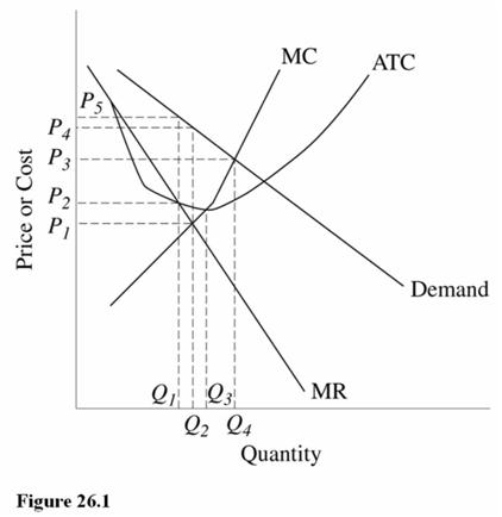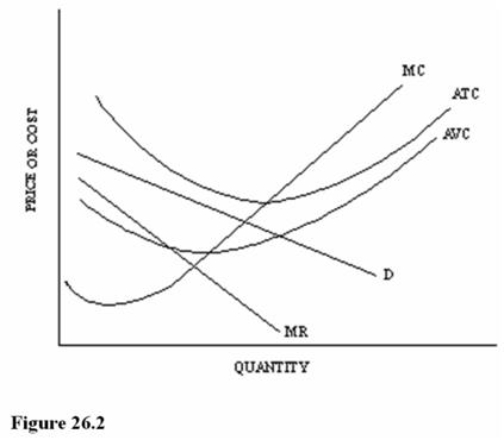A) MC is greater than MR.
B) Price is greater than MC.
C) ATC is greater than minimum ATC.
D) Diseconomies of scale exist.
Correct Answer

verified
Correct Answer
verified
Multiple Choice
 Refer to Figure 26.1 for a monopolistically competitive firm.The profit-maximizing output and price combination for this firm in the short run is
Refer to Figure 26.1 for a monopolistically competitive firm.The profit-maximizing output and price combination for this firm in the short run is
A) Q1, P1.
B) Q2, P4.
C) Q2, P1.
D) Q4, P3.
Correct Answer

verified
Correct Answer
verified
Multiple Choice
Demand and Cost Data for Will's Beach Ball Company
| Price | Demand Data Quantity | Cost Data Output | Total Cost |
|---|---|---|---|
| $11 | 6 | 6 | $48 |
| $10 | 7 | 7 | $52 |
| $9 | 8 | 8 | $57 |
| $8 | 9 | 9 | $63 |
| $7 | 10 | 10 | $70 |
A) negative; exit from
B) negative; entry into
C) positive; exit from
D) positive; entry into
Correct Answer

verified
Correct Answer
verified
Multiple Choice
Compared to the outcome under a marginal cost pricing strategy, a monopolistically competitive firm will produce a
A) Lower output and charge a higher price.
B) Greater output and charge a higher price.
C) Lower output and charge a lower price.
D) Greater output and charge a lower price.
Correct Answer

verified
Correct Answer
verified
Multiple Choice
Which of the following real-world situations is the result of excess capacity in a monopolistically competitive market?
A) A factory producing women's clothing produces more than it can sell during a season.
B) Gas stations with infrequently used pumps are located at all four corners of an intersection.
C) A retail auto tire store orders too much inventory.
D) Monopolistically competitive firms do not exist in the real world.
Correct Answer

verified
B
Correct Answer
verified
Multiple Choice
Monopolistic competition results in
A) Allocative efficiency.
B) Production efficiency.
C) The wrong mix of output.
D) Marginal cost pricing.
Correct Answer

verified
Correct Answer
verified
Multiple Choice
Large cities typically have many drugstores that offer different levels of service and product selection.The drugstore market in big cities can best be classified as
A) A competitive market.
B) Monopolistic competition.
C) Oligopoly.
D) Monopoly.
Correct Answer

verified
Correct Answer
verified
Multiple Choice
 Refer to Figure 26.2 for a monopolistically competitive firm.At the profit-maximizing output and price, this firm is producing at an output level that achieves
Refer to Figure 26.2 for a monopolistically competitive firm.At the profit-maximizing output and price, this firm is producing at an output level that achieves
A) Productive efficiency.
B) Allocative efficiency.
C) Maximum economies of scale.
D) Neither productive nor allocative efficiency.
Correct Answer

verified
Correct Answer
verified
Multiple Choice
Brand loyalty usually makes the demand curve for a product
A) More price-elastic.
B) Less price-elastic.
C) Unitary elastic.
D) More income-elastic.
Correct Answer

verified
Correct Answer
verified
Multiple Choice
Suppose that an economy wants to eliminate the resource waste associated with excess capacity in monopolistically competitive markets.Which of the following would achieve this goal?
A) Firms are allowed to establish significant barriers to entry.
B) Firms are encouraged to produce less output.
C) Firms are required to set price equal to marginal cost.
D) Firms are required to charge the same price.
Correct Answer

verified
Correct Answer
verified
Multiple Choice
Product differentiation occurs when
A) A completely new process is used to produce a familiar product.
B) One firm produces many varieties of a product.
C) Buyers perceive differences in the products of several companies.
D) Sellers perceive differences in the products of several companies.
Correct Answer

verified
Correct Answer
verified
Multiple Choice
According to "Fast-Food Rivals Suit Up for Breakfast War," what are companies like Starbucks, McDonalds, Wendy's, and Burger King trying to accomplish by entering the hot breakfast arena?
A) Create similar menus to those of each other.
B) Expand their franchises.
C) Increase revenues to build new stores.
D) Differentiate their products to establish and maintain brand loyalty.
Correct Answer

verified
Correct Answer
verified
Multiple Choice
If economic profits are earned in a monopolistically competitive market,
A) More firms will enter the market.
B) The market supply curve will shift to the left.
C) Price will rise.
D) The market demand curve will shift to the right.
Correct Answer

verified
Correct Answer
verified
Multiple Choice
AnIn the News article titled "Selling "Pure Water": A $Billion Scam?" refers to the use of advertising.When a firm successfully advertises its product, the firm
A) Has more control over its price.
B) Has less control over its price.
C) Still has no control over its price because all firms are price takers.
D) Has total control over its price.
Correct Answer

verified
A
Correct Answer
verified
Multiple Choice
A World View article titled "The Best Global Brands" discusses the value of brand names.Establishing brand loyalty can do all of the following except
A) Improve resource allocation efficiency.
B) Decrease the price elasticity of demand for the product.
C) Become a valuable economic asset.
D) Increase demand for the product.
Correct Answer

verified
Correct Answer
verified
Multiple Choice
Monopolistic competition results in allocative
A) Inefficiency and productive efficiency.
B) Inefficiency and productive inefficiency.
C) Efficiency and productive efficiency.
D) Efficiency and productive inefficiency.
Correct Answer

verified
Correct Answer
verified
Multiple Choice
Nonprice competition results in
A) Resource misallocation.
B) Low entry barriers.
C) Marginal cost pricing.
D) Production efficiency.
Correct Answer

verified
A
Correct Answer
verified
Multiple Choice
According to the article "What's Behind Starbucks'Price Hike?" in October 2006, Starbucks raised the price of its lattes, cappuccinos, drip coffee, and other drinks because of increases in wages and fuel costs.When it chose to hike prices, Starbucks was
A) Losing sales to its competitors and therefore needed higher prices to maintain revenue.
B) Relying on the economy to improve in order to offset the loss in sales as a result of the price hikes.
C) Relying on brand loyalty to prevent a significant loss in sales.
D) Relying on very elastic demand.
Correct Answer

verified
Correct Answer
verified
True/False
In monopolistically competitive markets, product differentiation is a significant barrier to entry.
Correct Answer

verified
Correct Answer
verified
Multiple Choice
Which of the following characterizes monopolistic competition?
A) Many interdependent firms sell a homogeneous product.
B) A few firms produce a particular type of product.
C) Many firms produce a particular type of product, but each maintains some independent control over its own price.
D) A few firms produce all of the market supply of a good.
Correct Answer

verified
Correct Answer
verified
Showing 1 - 20 of 150
Related Exams